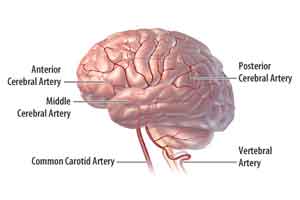- Home
- Editorial
- News
- Practice Guidelines
- Anesthesiology Guidelines
- Cancer Guidelines
- Cardiac Sciences Guidelines
- Critical Care Guidelines
- Dentistry Guidelines
- Dermatology Guidelines
- Diabetes and Endo Guidelines
- Diagnostics Guidelines
- ENT Guidelines
- Featured Practice Guidelines
- Gastroenterology Guidelines
- Geriatrics Guidelines
- Medicine Guidelines
- Nephrology Guidelines
- Neurosciences Guidelines
- Obs and Gynae Guidelines
- Ophthalmology Guidelines
- Orthopaedics Guidelines
- Paediatrics Guidelines
- Psychiatry Guidelines
- Pulmonology Guidelines
- Radiology Guidelines
- Surgery Guidelines
- Urology Guidelines
Stroke Facts in nutshell by American Stroke Association

Stroke is a medical condition characterized by interruption of blood supply to the brain resulting in damage to the brain cells. It is one of the leading cause of death in the U.S. and worldwide. About 800,000 people are affected by it in the U.S. per year that results in the death of about 130,000 people which are preventable but certain factors including lack of education, awareness, and resources are the major barriers to stopping it.
On the eve of the 20th anniversary of the American Stroke Association (ASA), it revealed important facts about the disease that should be known by all :
- There are different types of strokes: ischemic, hemorrhagic and transient ischemic attack (TIA). An ischemic stroke is a clot-caused blockage in an artery to the brain, while a hemorrhagic stroke occurs when an artery ruptures in the brain. A TIA or “mini-stroke” is caused by a temporary blockage. Eighty-seven percent of all strokes are ischemic.
- During a stroke, nearly 120 million brain cells die every hour. Compared with the normal rate of cell loss in brain aging, the brain ages 3.6 years each hour without treatment. The sooner the patient gets medical care, the better their chances of recovery.
- About 66 percent of the time, someone other than the patient makes the decision to seek treatment – recognizing the warning signs and sudden symptoms of stroke to receive treatment fast, could help save a life.
- F.A.S.T. is an acronym used to teach the most common warning signs and sudden symptoms of stroke. F.A.S.T. stands for (F) face drooping, (A) arm weakness, (S) speech difficulty, (T) time to call 9-1-1. Less than half of the population is aware of the signs.
- The symptoms can also include sudden numbness, sudden trouble seeing in one or both eyes, sudden severe headache with no known cause and sudden trouble walking.
- Calling an ambulance is the fastest way to get treated quickly during a stroke emergency. Driving to the hospital is a common mistake people make, that can result in longer wait times before the patient receives medical care.
- Patients who have an ischemic stroke may have a treatment window for mechanical clot removal within six hours to up to 24 hours in certain patients with clots in large vessels.
- Alteplase (also known as tPA) is a drug used to dissolve a blood clot that causes stroke. Such patients who arrive at a hospital within 90 minutes of symptom onset and qualify to receive tPA are almost 3 times more likely to recover with little or no disability.
- Having a stroke increases the risk of a second one (1 in 4 survivors have another episode). Prevention is crucial because the second episode can be more debilitating than first episode.
- In some ischemic stroke cases, the cause is unknown (cryptogenic). It’s a challenge to prevent a second episode when the cause of the first one is unknown. The patient should work with their healthcare team to find the root cause.
- Stroke survivors stopping their aspirin regimen can up their risk of having another episode, possibly due to increased clotting levels from the loss of aspirin’s blood-thinning effects. Following an aspirin regimen can help prevent it in some survivors.
- First-ever ASA rehabilitation guidelines call for intensive, team approach. For the first three months after a stroke, the brain is ready to learn. This ability for our brains to adjust is known as neuroplasticity and it plays a crucial role in recovery.
- More episodes are happening to people in their 30s and 40s.
- High blood pressure is the most common controllable cause of stroke. Recent guidelines redefined high blood pressure as a reading of 130/80 mm Hg or higher. A normal reading would be any blood pressure below 120/80 mm Hg and above 90/60 mm Hg in an adult
- Other risk factors are : obesity, diabetes, cholesterol, smoking and family history.
- Eighty percent of strokes are preventable. Eating healthfully, being physically active and controlling risk factors are important lifestyle changes that can help prevent and beat it.
“We must aggressively continue our efforts to reduce stroke, especially in multicultural communities and to reach people at younger ages,” said Mitchell S.V. Elkind, M.D., a professor of Neurology and Epidemiology at Columbia University. “If people are not aware of how to prevent, treat and beat stroke, they can’t take advantage of the progress made over the last twenty years to save lives.”

Disclaimer: This site is primarily intended for healthcare professionals. Any content/information on this website does not replace the advice of medical and/or health professionals and should not be construed as medical/diagnostic advice/endorsement or prescription. Use of this site is subject to our terms of use, privacy policy, advertisement policy. © 2020 Minerva Medical Treatment Pvt Ltd